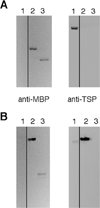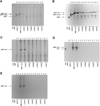The C-terminus of the P22 tailspike protein acts as an independent oligomerization domain for monomeric proteins
- PMID: 19196242
- PMCID: PMC4561578
- DOI: 10.1042/BJ20081449
The C-terminus of the P22 tailspike protein acts as an independent oligomerization domain for monomeric proteins
Abstract
TSP (P22 tailspike protein) is a well-established model system for studying the folding and assembly of oligomeric proteins, and previous studies have documented both in vivo and in vitro folding intermediates using this protein. Especially important is the C-terminus of TSP, which plays a critical role in the assembly and maturation of the protrimer intermediate to its final trimeric form. In the present study, we show that by grafting the C-terminus of TSP on to the monomeric MBP (maltose-binding protein), the resulting chimaera (MBP-537) is a trimeric protein. Moreover, Western blot studies (using an anti-TSP antibody) indicate that the TSP C-terminus in the MBP-537 chimaera has the same conformation as the native TSP. The oligomerization of the MBP-537 chimaera appears to involve hydrophobic interactions and a refolding sequence, both of which are analogous to the native TSP. These results underscore the importance of the TSP C-terminus in the assembly of the mature trimer and demonstrate its potential utility as a model to study the folding and assembly of the TSP C-terminus in isolation.
Figures






References
-
- Steinbacher S, Seckler R, Miller S, Steipe B, Huber R, Reinemer P. Crystal structure of P22 tailspike protein: interdigitated subunits in a thermostable trimer. Science. 1994;265:383–385. - PubMed
-
- Seckler R, Fuchs A, King J, Jaenicke R. Reconstitution of the thermostable trimeric phage P22 tailspike from denatured chains in vitro. J. Biol. Chem. 1989;264:11750–11753. - PubMed
-
- Miller S, Schuler B, Seckler R. A reversibly unfolding fragment of P22 tailspike protein with native structure: the isolated β-helix domain. Biochemistry. 1998;37:9160–9168. - PubMed
Publication types
MeSH terms
Substances
Grants and funding
LinkOut - more resources
Full Text Sources
Miscellaneous

